#spatial transparencies
Explore tagged Tumblr posts
Video
Spatial Practices : Tate Modern. #7 by Russell Moreton Via Flickr: OLYMPUS DIGITAL CAMERA
#sculpture#spatial practices#occupancy#participation#reflection#space#material#movement#Tate Modern#rooms#inquiry#speculation#colour#texture#form#architectural surfaces#art practices#russell moreton#research#agenda#documentation#research artist#visual cartography#evocative spaces#entanglements#colour and light#spatial transparencies#finality#ambiguity#continuity
2 notes
·
View notes
Text
Mivi SuperPods Halo [Flagship Launch], True Wireless Earbuds, ANC Earbuds with 3D Soundstage, 60H Playtime, Spatial Audio, 13mm Driver, Transparency Mode Earbuds
Price: (as of – Details) Adaptive Quiet ANC for proactively detecting and reducing noise before it enters the ear canal. This makes it effective against consistent, predictable noises like the bustle of a metro or the commotion of traffic while commuting on the road.Feel the new depths of 3D Soundstage taking you deeper into the sound dimension with each instrument orchestrated for a deeper…

View On WordPress
#13mm#60H#ANC#Audio#Driver#Earbuds#Flagship#Halo#Launch#Mivi#mivi earbuds wireless earbuds#Mode#Playtime#Soundstage#Spatial#SuperPods#Transparency#True#Wireless
0 notes
Text
we've found it folks: mcmansion heaven
Hello everyone. It is my pleasure to bring you the greatest house I have ever seen. The house of a true visionary. A real ad-hocist. A genuine pioneer of fenestration. This house is in Alabama. It was built in 1980 and costs around $5 million. It is worth every penny. Perhaps more.
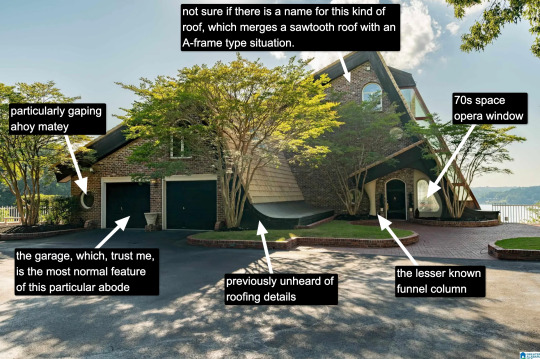
Now, I know what you're thinking: "Come on, Kate, that's a little kooky, but certainly it's not McMansion Heaven. This is very much a house in the earthly realm. Purgatory. McMansion Purgatory." Well, let me now play Beatrice to your Dante, young Pilgrim. Welcome. Welcome, welcome, welcome.
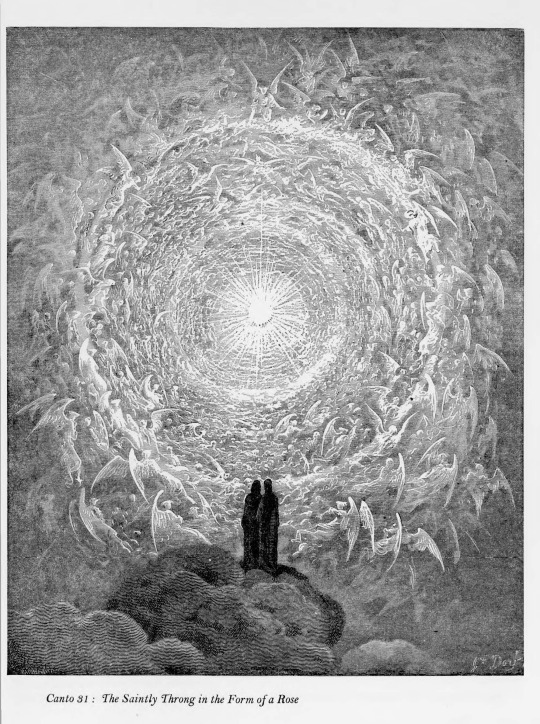
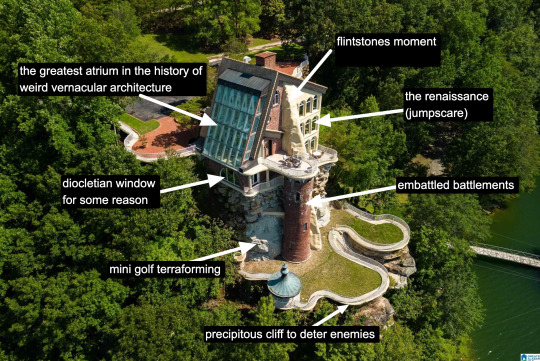
It is rare to find a house that has everything. A house that wills itself into Postmodernism yet remains unable to let go of the kookiest moments of the prior zeitgeist, the Bruce Goffs and Earthships, the commune houses built from car windshields, the seventies moments of psychedelic hippie fracture. It is everything. It has everything. It is theme park, it is High Tech. It is Renaissance (in the San Antonio Riverwalk sense of the word.) It is medieval. It is maybe the greatest pastiche to sucker itself to the side of a mountain, perilously overlooking a large body of water. Look at it. Just look.
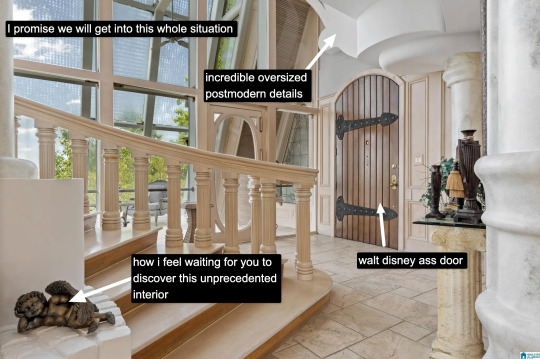
The inside is white. This makes it dreamlike, almost benevolent. It is bright because this is McMansion Heaven and Gray is for McMansion Hell. There is an overbearing sheen of 80s optimism. In this house, the credit default swap has not yet been invented, but could be.
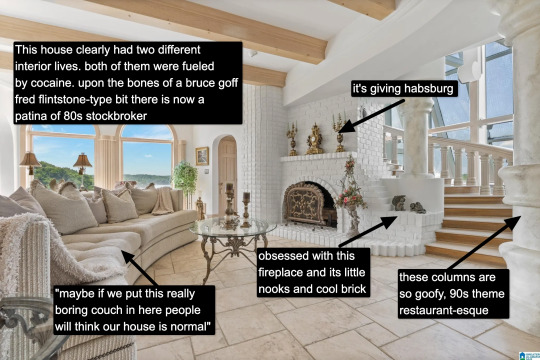
It takes a lot for me to drop the cocaine word because I think it's a cheap joke. But there's something about this example that makes it plausible, not in a derogatory way, but in a liberatory one, a sensuous one. Someone created this house to have a particular experience, a particular feeling. It possesses an element of true fantasy, the thematic. Its rooms are not meant to be one cohesive composition, but rather a series of scenes, of vastly different spatial moments, compressed, expanded, bright, close.
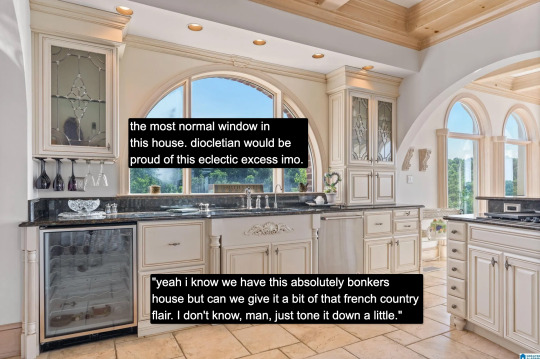
And then there's this kitchen for some reason. Or so you think. Everything the interior design tries to hide, namely how unceasingly peculiar the house is, it is not entirely able to because the choices made here remain decadent, indulgent, albeit in a more familiar way.

Rare is it to discover an interior wherein one truly must wear sunglasses. The environment created in service to transparency has to somewhat prevent the elements from penetrating too deep while retaining their desirable qualities. I don't think an architect designed this house. An architect would have had access to specifically engineered products for this purpose. Whoever built this house had certain access to architectural catalogues but not those used in the highest end or most structurally complex projects. The customization here lies in the assemblage of materials and in doing so stretches them to the height of their imaginative capacity. To borrow from Charles Jencks, ad-hoc is a perfect description. It is an architecture of availability and of adventure.
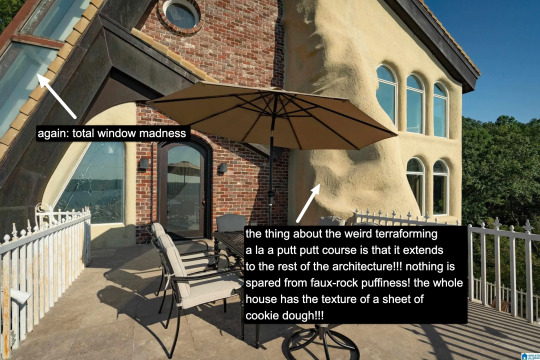
A small interlude. We are outside. There is no rear exterior view of this house because it would be impossible to get one from the scrawny lawn that lies at its depths. This space is intended to serve the same purpose, which is to look upon the house itself as much as gaze from the house to the world beyond.
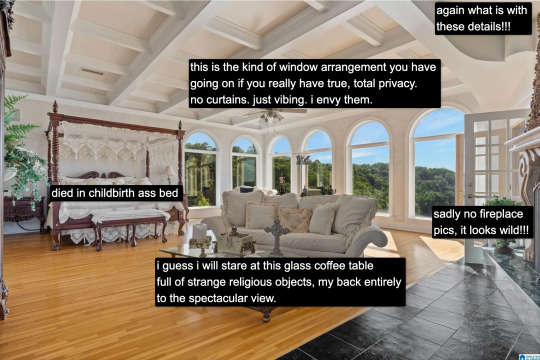
Living in a city, I often think about exhibitionism. Living in a city is inherently exhibitionist. A house is a permeable visible surface; it is entirely possible that someone will catch a glimpse of me they're not supposed to when I rush to the living room in only a t-shirt to turn out the light before bed. But this is a space that is only exhibitionist in the sense that it is an architecture of exposure, and yet this exposure would not be possible without the protection of the site, of the distance from every other pair of eyes. In this respect, a double freedom is secured. The window intimates the potential of seeing. But no one sees.
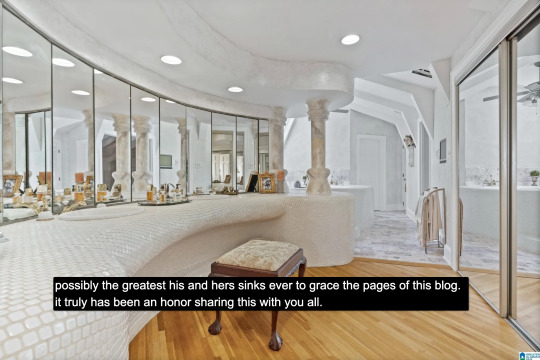
At the heart of this house lies a strange mix of concepts. Postmodern classicist columns of the Disney World set. The unpolished edge of the vernacular. There is also an organicist bent to the whole thing, something more Goff than Gaudí, and here we see some of the house's most organic forms, the monolith- or shell-like vanity mixed with the luminous artifice of mirrors and white. A backlit cave, primitive and performative at the same time, which is, in essence, the dialectic of the luxury bathroom.
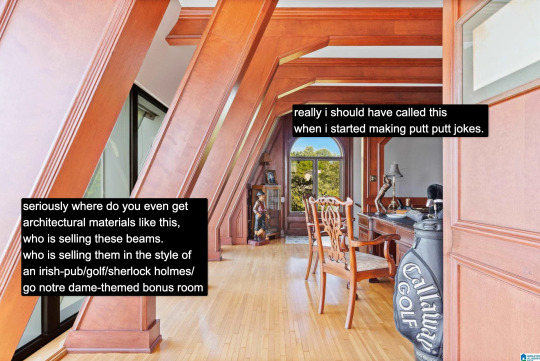
And yet our McMansion Heaven is still a McMansion. It is still an accumulation of deliberate signifiers of wealth, very much a construction with the secondary purpose of invoking envy, a palatial residence designed without much cohesion. The presence of golf, of wood, of masculine and patriarchal symbolism with an undercurrent of luxury drives that point home. The McMansion can aspire to an art form, but there are still many levels to ascend before one gets to where God's sitting.
If you like this post and want more like it, support McMansion Hell on Patreon for as little as $1/month for access to great bonus content including a discord server, extra posts, and livestreams.
Not into recurring payments? Try the tip jar! Student loans just started back up!
43K notes
·
View notes
Text
Who gets to be human? On Black geographies, damned people living in inhospitable places, other ways of knowing and being, and racist legacy of European academic epistemologies.
---
---
The idea of the plantation is migratory. [...] Past colonial encounters created material and imaginative geographies that reified global segregations through “damning” the spaces long occupied by Man's human others. Here, damning can be understood in two interlocking ways: as a fencing in and as a condemnation of racial-sexual difference. The uninhabitable - in particular, the landmasses occupied by those who, in the fifteenth and sixteenth centuries, were unimaginable, both spatially and corporeally - is the geographic (non)location through which the plantation emerged. From Caliban's “uninhabited” island in Shakespeare's The Tempest, to the regions within Africa identified as too hot to be livable, the landmasses deemed uninhabitable presented a geographic predicament upon “discovery.” [...] [A] "new symbolic construct of race," which coincided with post-1492 colonial arrangements, organized much of the world according to a racial logic. [...] The colonial enactment of geographic knowledge mapped “a normal way of life” through measuring different degrees of humanness and attaching different versions of the human to different places. […] [I]n the sites of toxicity, environmental decay, pollution […] inhabited by impoverished communities […] the [current] geographies of the racial other are emptied out of life precisely because the historical constitution of these geographies has cast them as lands of no one. So in our present moment, some live in the unlivable, and to live in the unlivable condemns the geographies of marginalized to death over and over again. Life, then, is extracted from particular regions […]. If we believe that the city [the prison, the resort, other "postcolonial spaces"] is the commercial expression of the plantation and its marginalized masses, and that the plantation is a persistent but ugly blueprint of our contemporary spatial troubles, Wynter's essay asks that we seek out secretive histories […]. [R]acial violence haunts, [...] the struggles we face, intellectually, are a continuation of plantation narratives that dichotimize geographies into us/them and hide secretive histories that undo the teleological [...] underpinnings of [colonial, imperial, modern] spatiality.
Text by: Katherine McKittrick. “Plantation Futures.” Small Axe, Volume 17, Number 3, November 2013 (No. 42), pages 1-15. [Emphasis mine.]
---
---
Registering the marine world as central to the making of modernity - from slave ships and sea-borne empires to container logistics and the industrialized extraction of its resources (from fish to fossil fuels) - we encounter the constant of colonialism in the haunting racism that produces the violent grammar of inhospitality, today etched on the body of the contemporary migrant. [...] This is to interrupt and rework Occidental historiography, sociology, and philosophy, and to puncture their faith in rendering the world transparent to their will. […] Promoting the instability of critical language is to take responsibility for what Achille Mbembe calls the becoming-black of the world: where the production of subjection provokes alternative knowledge, practices, and politics […]. Today the increasing use of drones in the Mediterranean as part of the technology of governance marks the latest abandonment of social responsibility to the bio-surveillance of unwanted bodies and discarded lives. Smart borders take migrants far below the category of “bare life,” [...] and extends the racial profiling written into the historical premises that betray their deep incubation in the refusal to register the languages and limits of the white myths [...]. From the Black Atlantic to the Black Mediterranean: seas of dispossession and unbelonging have constantly demonstrated the political, juridical, and onto-epistemological limits of modernity. They promote a constant critique of the epistemic foundations of Western [colonial "liberalism"]. Those on the water, the wretched of the sea, the damned [...], who cannot source their identity in the territory of the nation-state, are without rights. They have no social [...] validity. [...] Yet they simultaneously [...] exist, persist, and resist. [...] The algorithm sputters in the dark while cut-up, bricolage, collage, and montage work the critical gaps [...]. The archives unwind to expose other computations of time and further folds in space: the promise of foreign cartographies [...].
Text by: Iain Chambers. A section by Chambers in the essay co-authored by Tiziana Terranova and Iain Chambers. “Technology, Postcoloniality, and the Mediterranean.” e-flux Journal Issue #123. December 2021. [Emphasis mine.]
---
---
[T]he framing of the inhumanities forces a reckoning with the humanist liberal subject that orders the humanities: an invisible and indivisible white subject position [...]. In Césaire’s (2000 [1972]) Discourse on Colonialism, he suggested that “at the very time when it most often mouths the word, the West has never been further from being able to live a true humanism [...]”. In another searing critique of [White, European, liberal/colonial] humanism, Fanon (1961) tied the unrealized figure of a true humanism to the earth, as a wretched counterpoint, whereby the inhuman residues of the colonial project abide as discarded matter […]. Those blackened colonial afterlives in “modernity’s project of unfreedom” (Walcott 2014, 94) are still very much present in the political geologies of climate change vulnerabilities, the wasting effects of racial capitalism, and neo-extractivist economies […]. The narrative arc of humanism, Scott (2000) suggested in conversation with Wynter, is often told as a kind of European coming-of-age story. […] The Anthropocene discourse follows the same coming-of-age humanist script [...]. Sylvia Wynter, W.E.B. DuBois, and Achille Mbembe all showed how that genealogy of man [as universal concept] was underscored by the racial division of life and nonlife. […] In its simplest iteration, there are forms of life on one side and nonlife on the other; nonlife that is constituted through death, and more recently in Mbembe and Povinelli’s writing through forms of social death, exhaustion, and extinguishment, wherein nonlife emerges as a zone of governance. The gravitational pull that centers these divisions between life and nonlife is the human subject as it is conceived through a Western normative frame [...]. As new forms of racialized beings were articulated through sixteenth- through nineteenth-century paleontology in the context of colonialism, geology was also articulating new origins of the earth, as well as forming the material praxis of their rearrangement (through mining, ecological rearrangements and extractions, and forms of geologic displacements such as plantations, dams, fertilizers, crops, and introduction of “alien” animals). [...] Historically, this normative sphere of humanism was racist and specifically antiblack, and without challenging that history, it remains so, every time the universal or human is invoked. Some of the greatest challenges, of course, came from anticolonial thinkers struggling to make sense of their painful histories in their fullest terms, such as Fanon (1959, 1961), Césaire, Glissant, C. L. R. James and Wynter. As Wynter (2000) commented, “The degradation of concrete humans, that was/is the price of empire, of the kind of humanism that underlies it” (154). For Wynter (2000), “what is called the West [...] begins with the founding of post-1492 Caribbean” (152). Wynter challenged the geographical imaginary that the Americas and Caribbean are somehow an epistemological outside to Western knowledge […].
Text by: Kathryn Yusoff. “The Inhumanities.” Annals of the American Association of Geographers, Volume 11, Issue 3. November 2020. [Emphasis mine.]
---
---
But what becomes of the native-occupied “uninhabitable” zones is a geo-racial reorganization. The “new symbolic construct of race,” which coincided with post-1492 colonial arrangements, was spatially organized according to a new […] logic. […] That is, the uninhabitable […] is underscored by racial and sexual differences. To transform the [land] […], and make this transformation profitable, the land must become a site of racial-sexual regulation, a geography that maps “a normal way of life” […] This is expressed through uneven geographies: spatial arrangements [...]. The inhabitability [...] also produces [...] forms of geographic nonexistence, which differ from what was assumed was "not there." [...] [W]hat Edouard Glissant describes as the "real but long unnoticed" places [...]: cultural sharings, new poetics, new ways of being [...]. Those who occupy the spaces of Otherness are always already encountering space and therefore articulate how genres or modes of humanness are intimately connected to where we/they are ontologically as well as geographically. To return to an earlier discussion, spaces of Otherness are “palpitating with life.” [...]
Text by: Katherine McKittrick. “Demonic Grounds: Sylvia Wynter.” Demonic Grounds: Black Women and The Cartographies of Struggle. 2006. [Emphasis mine.]
#sorry doing this in breakroom at work#tidalectics#black methodologies#really want to also place next to this my summaries of an laura stolers writing on imperialist nostalgia and academic anthropology#as sometimes functioning basically imperial intellectual tourism or entertainment but stuck at work and cant find and edit them#ecologies#multispecies#katherine mckittrick#abolition#kathryn yusoff#geographic imaginaries#indigenous pedagogies#fred moten#pleistocene
45 notes
·
View notes
Text
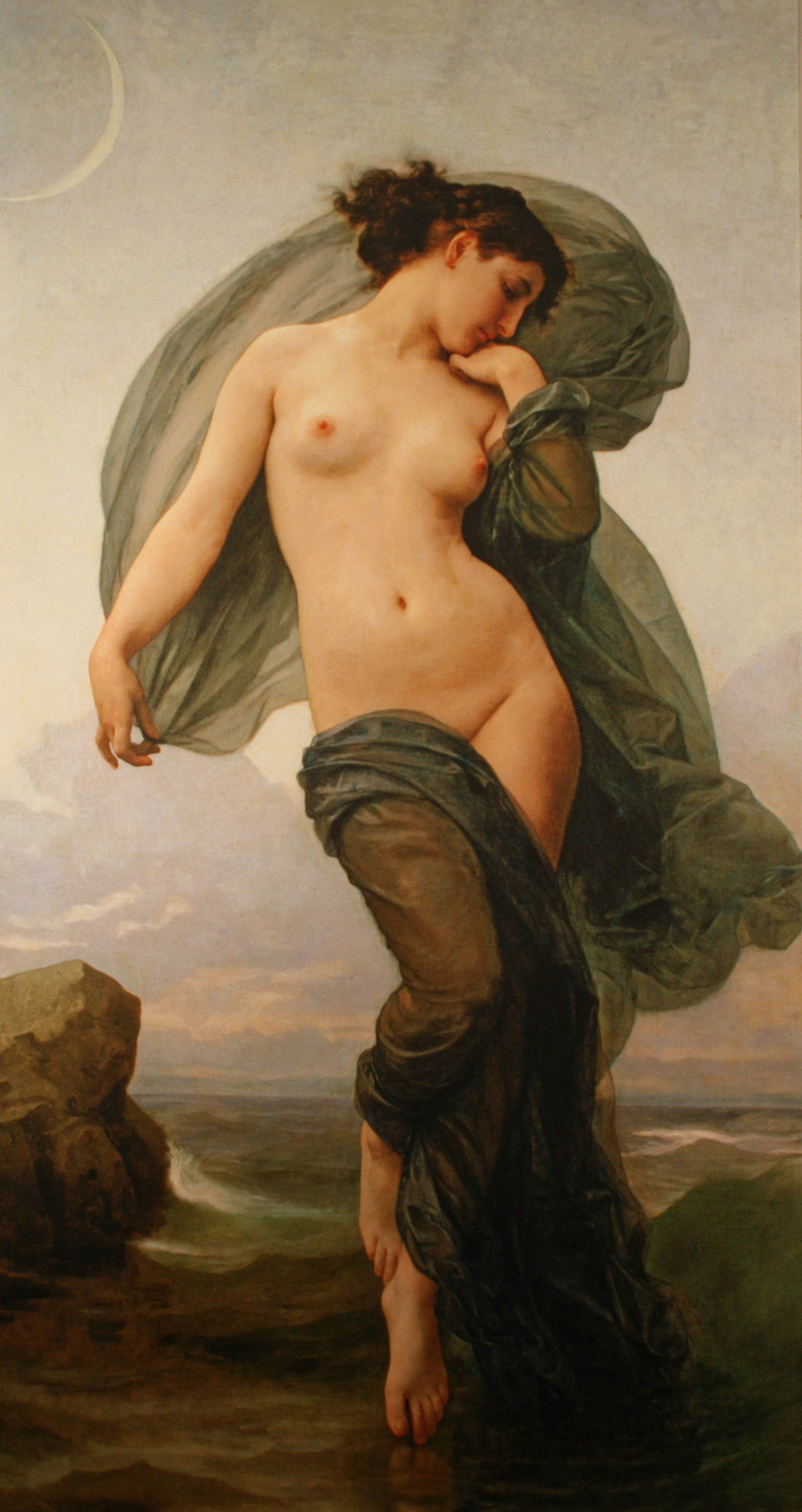
Evening Mood (William-Adolphe Bouguereau, 1882)
In an article for Spatial Vision, Baingio Pinna praises Bouguereau's technical skill, writing:
The female sensuality is mainly due to the realistic representation of the young woman and to the enveloping transparent veil moving slowly all around her body and, at a more primary phenomenal level, also to the sinusoid wavy lines that seem to dance synergistically and harmonically through their good continuation.
#art#oil painting#painting#beautiful body#natural body#amazing body#skin#80s#evening mood#William-Adolphe Bouguereau#academic art#18 century#oil on canvas#art history#aestethic#vintage aesthetic#museum#academicism
99 notes
·
View notes
Text
HOW IS OUR UNIVERSE EXPANDING??
Blog#308
Saturday, June 24th, 2023
Welcome back,
The universe was born with the Big Bang as an unimaginably hot, dense point. When the universe was just 10-34 of a second or so old — that is, a hundredth of a billionth of a trillionth of a trillionth of a second in age — it experienced an incredible burst of expansion known as inflation, in which space itself expanded faster than the speed of light. During this period, the universe doubled in size at least 90 times, going from subatomic-sized to golf-ball-sized almost instantaneously.

The work that goes into understanding the expanding universe comes from a combination of theoretical physics and direct observations by astronomers. However, in some cases astronomers have not been able to see direct evidence — such as the case of gravitational waves associated with the cosmic microwave background, the leftover radiation from the Big Bang.

A preliminary announcement about finding these waves in 2014 was quickly retracted, after astronomers found the signal detected could be explained by dust in the Milky Way.
According to NASA, after inflation the growth of the universe continued, but at a slower rate. As space expanded, the universe cooled and matter formed. One second after the Big Bang, the universe was filled with neutrons, protons, electrons, anti-electrons, photons and neutrinos.

During the first three minutes of the universe, the light elements were born during a process known as Big Bang nucleosynthesis. Temperatures cooled from 100 nonillion (1032) Kelvin to 1 billion (109) Kelvin, and protons and neutrons collided to make deuterium, an isotope of hydrogen. Most of the deuterium combined to make helium, and trace amounts of lithium were also generated.
For the first 380,000 years or so, the universe was essentially too hot for light to shine, according to France's National Center of Space Research (Centre National d'Etudes Spatiales, or CNES).

he heat of creation smashed atoms together with enough force to break them up into a dense plasma, an opaque soup of protons, neutrons and electrons that scattered light like fog.
Roughly 380,000 years after the Big Bang, matter cooled enough for atoms to form during the era of recombination, resulting in a transparent, electrically neutral gas, according to NASA. This set loose the initial flash of light created during the Big Bang, which is detectable today as cosmic microwave background radiation.

However, after this point, the universe was plunged into darkness, since no stars or any other bright objects had formed yet.
About 400 million years after the Big Bang, the universe began to emerge from the cosmic dark ages during the epoch of reionization. During this time, which lasted more than a half-billion years, clumps of gas collapsed enough to form the first stars and galaxies, whose energetic ultraviolet light ionized and destroyed most of the neutral hydrogen.

Although the expansion of the universe gradually slowed down as the matter in the universe pulled on itself via gravity, about 5 or 6 billion years after the Big Bang, according to NASA, a mysterious force now called dark energy began speeding up the expansion of the universe again, a phenomenon that continues today.
A little after 9 billion years after the Big Bang, our solar system was born.

The Big Bang did not occur as an explosion in the usual way one think about such things, despite one might gather from its name. The universe did not expand into space, as space did not exist before the universe, according to NASA. Instead, it is better to think of the Big Bang as the simultaneous appearance of space everywhere in the universe. The universe has not expanded from any one spot since the Big Bang — rather, space itself has been stretching, and carrying matter with it.
Originally published on space.com
COMING UP!!
(Wednesday, June 28th, 2023)
"IS THE MOON RUSTING??"
184 notes
·
View notes
Text

SPATIAL MIMICRY
Тарsolepis taiwana is a butterfly species that disguises itself as pieces of tree bark. Not just ordinary pieces, but small, torn, with voids inside. The role of voids is played by silver-white 'windows' in the wings, creating the illusion of empty space. And under the imaginary void hides a massive belly of a butterfly, topped with tufts of bristles.
It is interesting that although there are quite a few species with transparent wings or parts of them among butterflies, very few species have reached the creation of a 'spatial illusion'. And South Asian crested butterflies of the genus Tarsolepis are among the most perfect 'illusionists'.
10 notes
·
View notes
Text
Part 2. About Professionalism and Bullet Catching
This post is in Russian/Этот пост есть на русском, здесь.
Preface "Marvelous!" | Part 1 | Supplement one to Part 1 | Supplement two to Part 1 Reading the supplements is not necessary to understand this post.
This post involves some guesswork that might lead to doubt. However, we were shown a clear and insightful parallel between the scenes "in the magic shop" and "in Edinburgh," which helps us understand the techniques used to create these parallels. For instance:
One element can convey multiple meanings.
The significance of phrases, sounds, colors, and the spatial relationships of objects is crucial.
Characters can mirror the main characters, as couples do.
Emotions may be similar, but in the mirrored scene, they feel more genuine than in the original.
Here I’ll be referring to the final fifteen-minute conversation scene between Aziraphale and Crowley as "the final 15" for short. I see a cool system of parallels between this scene and the performance of the Fabulous Mr. Fell in the West End in 1941.
"Broken Bottles"
Broken bottles are associated with a cancelled breakfast at the Ritz: someone didn't get the pile of alcohol they were expecting, and the angel volunteered to do a magic trick instead.
"Beginning of the performance"
So, Aziraphale goes on stage. The owner of the theater, Mrs. H, urges him: "You're on. Get on with it!"
When Aziraphale enters the bookstore, having received Metatron's offer, I want to exclaim the same thing in his direction.
The angel hesitates and drags his feet for the first few minutes on stage. The manager in the theater yells "Get on with it!" at him in disgust. In the bookshop, too. Isn't that what everyone in the viewers wanted to yell at the angel along with Crowley when he interrupted the demon and started to hesitate and drag his feet in the bookshop? "Come on, Angel!"

However, Aziraphale gave Crowley at least two clues with his performance in the bookshop: a timeout sign with his palms and a silent phrase. And that's not counting the fact that he was grotesquely and contrary to his beliefs happy about the offer he received.
And Azi didn't waste any time on stage either! True, we, the audience, got the clues.
Hint 1. "Ladies from Camelot"
"They were the ladies from Camelot," says the angel, barely having entered the stage. Guessed? That's Nina and Maggie, who left the bookshop when he entered!
Hint 2. "Bees"
Then Azi says: "They're the bees knees!"
And remember when Crowley went to Heaven with Muriel?
- My office, but... - Lead on. - But... No, I can't! You're a demon! I can't just... Do you know how much trouble I'll get into for this? - It's fine. You're forgetting about the bees. - Bees? - Angels are like bees. Fiercely protective of their hive if you're trying to get inside. Once you're in... - Well, I mean... Is it even faintly possible that an unauthorized demon might be just wandering around in Heaven unescorted? [Muriel shakes her head] - Mm, bees. - But you don't look like a bee. You look like a murder hornet or a snake or a... [Crowley changes his outfit.] - Bees. Right.
Michael met Crowley in the corridor of Heaven, but did not pay attention to him. Michael and other angels are bees that were fooled.
"Ladies of Camelot" Nina and Maggie went into a bookshop before the final 15. Aziraphale, entering the bookstore after talking to Metatron, met both ladies on the way out, but paid no attention to them, just as Michael paid no attention to Crowley in Heaven. Now were Crowley himself, together with Aziraphale, the bees that were fooled? Azi and Crowley let Nina and Maggie into the store thinking it was safe, but that was a mistake!
Oh, another poster in the fandom has argued this already! It was no coincidence that Nina and Maggie influenced Crowley's thoughts. And I did not believe this post initially. Well, now I bow to this transparent parallel. Maybe the girls were bewitched by Metatron, and it was not them themselves, but the fact of sabotage has been established.
Hint 3. "Portion (jigger)"
And Azi also says jiggery-pokery on stage. Remember Metatron's hefty jigger (huge spoon/portion)?
"Invitation for Crowley"
It's terribly sweet that Azi then says: "first, I shall require the assistance of a gentleman from the audience." That is, he needs Crowley as an ally in the final 15. But the demon doesn't immediately realize that he is being called from the audience, that he needs to raise his hand. He doesn't immediately realize in the final 15 that he needs to play along.
"Turn a turnip into an inkwell"
Aziraphale can't turn a turnip into an inkwell. And what a strange choice of objects, don't you think? I have the audacity to interpret this as Azi not being able to get through to Crowley. At least, the angel thinks it doesn't work. Oh, demon, you're being stupid, you're just a turnip! You've become so bright! You haven't done a single demonic mischief in the modern part of the second season, at least not intentionally! Where is your demonic ingenuity, where are your ink pens with sharp ends?
Although, to be fair, Crowley also tried to transform a turnip. But he couldn't either. Here, most likely, the parallel is this: he tried to stop time, but he couldn't. It's a pity that it is not yet known for sure about stopping time. We only have the clock hints.
But now that we can look, we have two confirmations in addition to the hands that stopped in the bookshop behind the demon! Crowley really tried to stop time in the final 15!
"Crowley is a Time Lord"
Hint 1. "Fez in a Trick Shop"

In the modern part of the story, Aziraphale and Crowley come to a magic shop and talk to a new salesman. It is no coincidence that Azi starts tempting this salesman with the book "Expert at the Card Table" to lure him to a meeting-ball, that is, he also seriously wants to share his expertise. Aziraphale worked like a real expert in the finale. Everything he did was great, necessary and correct.
And Crowley is cosplaying Doctor Who in a magic shop. It turns out that this famous Easter egg-reference to the time lord is not just there for fun, but works to understand the ending. Crowley's emotion is boredom, but maybe it rhymes with his impatience while Aziraphale was hesitating in the final 15.
Notice that Crowley, wearing the Doctor's fez, moves his hands over the glass ball, as if embracing and covering it. Why? We already know that there are no coincidences in parallels. Only now the ball is Earth. Because Crowley helped protect Earth from Armageddon in the first season by stopping time, like a true master of time.
It turns out that the demon in the final 15 did try to stop time. Now I find it hard to believe that the standing arrow was a blooper. Are bloopers even possible in the polished diamond that is Good Omens?!
Confirmation 2. "Doctor Who continued"

We were reminded that Crowley is a time lord by a shot in 1941 where he is sitting in the audience. The Good Omens team really did line up the shot with Crowley, as well as the return shot with Azi, so that I would notice the association of these shots with shots from Doctor Who, and Crowley himself with a time lord!
It's just a pity that the reminder of the power over time was given shortly before the key events on stage, and not at the same time as Crowley's attempt to turn a turnip into an inkwell. But wait a minute!..
Eureka!
Where else was "have a gold star" said by Crowley to Muriel? In the Season 1 scene at the airbase, Crowley said this to Adam shortly before he stopped time: "Well done. Have a gold star. Won't make any difference."
Update: And also at the airfield Crowley threw the book of prophecies into Anathema's hands, and in the bookshop he threw the book into Muriel's hands (thanks @kimberleyjean).
And in the final 15, we were given this reminder shortly before Crowley tried to stop time. Perfect symmetry with the first season and the audience in 1941 is guaranteed!

Now I need an assistant who will collect and analyze all the references to time in the series. Because the characters sometimes have too much time, sometimes not enough.
"Crowley takes the stage"
Although the miracles were blocked, and in both cases there was clearly some kind of crazy thing going on, but "sometimes you meet stubborn turnips." Crowley, despite suspecting something was wrong, still began his monologue-confession in the finale.
Well. “So... best get on to the main event. Tonight... I will take my life in my hands.” This is Aziraphale getting ready to catch a bullet. He is so cool, a real professional! In both scenes. Even though it is difficult for him. I am absolutely delighted!
When Crowley takes the stage, Azi, of course, tries to maintain the legend that Crowley is a randomly selected spectator. Look, audience, this is a complete stranger to me. Believe me, we are not friends. Do you hear that, Metatron, you bastard?
"Shot"

Well, about the angel's "aim at my mouth" only the lazy have not joked that it was about a kiss. In general, the phrase "aim at my mouth, but shoot past the ear" is too ridiculous to mean anything. But what does the ear have to do with it then? Is this the angel's words "I can't hear anything" about nightingales?
In the conversation shots, they often show Crowley from right behind Aziraphale's ear, and only his ear is visible. Not only is the angel's ear the only thing we see during the kiss, but Aziraphale also closes his eyes... Like in 1941 before the shot.
As for the meaning of the phrases "nothing lasts forever", as well as from 1941: "trust me", "at my signal" and "take this bullet and load it into the rifle.", I have not yet figured out exactly.
But now we need to discuss the shot. And the shot is a kiss.
"Aziraphale in the crosshairs"

I noticed that the sight is the shape of the neckline of Maggie's blouse. She has a blue ribbon in the center of the dark circle of the neckline. Yes, the shape of the ribbon refers to the snake, because Maggie is an analogy with Crowley. But objects in the series often have a double meaning. Let me remind you that blue is Aziraphale's color, and red is Crowley's color. Just remember the paintball paint in the first season! They were both also shot at then. So now Maggie's blue ribbon is Aziraphale shown through the gun sights.
"The True Emotions of a Kiss"
When Crowley took aim, he was absolutely terrified. I wouldn't be surprised if he was in the same state when he realized he was kissing an angel. Aziraphale was also very scared to stand under the gun. But he trusts Crowley infinitely, and the fear during the kiss was most likely caused by Metatron watching them.
I think we shouldn't discount the incredible happiness and relief when they successfully completed the trick. Because in fact, if not for the circumstances, the kiss would have been a happy one for them. I add this hint to my collection of confirmations that the third season will end happily.
"Bullet in the teeth"

Apparently, that glimpse of spit in Aziraphale's mouth that fans noticed in the final 15 after the kiss was added by the creators to rhyme with the bullet in his teeth in 1941. I don't think there's a physical bullet in the ending. A shine of spit is just what is needed to connect scenes and sequence events. Paralleling objects are never completely identical. For example, even when we had three mirrors, they were still different: wall, table and pocket. So my opinion is that in the end it’s just saliva.
Update: I've already changed my mind. Crowley could have given Aziraphale an object through a kiss. I was convinced by the scene in which Maggie walks from her record store to the meeting-ball in a black and red T-shirt with a picture of a man in black glasses.
I'll quote from this Russian post.
"She locks her little store with a ✨key✨ and holds it at the level of the ✨lips✨ of the man depicted on the T-shirt. Then she puts the keys in her other hand and throws them into a ✨tartan✨ bag, which closes with difficulty. Probably, the kiss was so strange and long because the "bag" at first resisted the transfer of important information.
"I forgive you"
This phrase has a reference to the first season, so we can assume that this nightmare phrase for Crowley hints at something. Aziraphale, of course, was shocked, but remember that he also managed to behave Professionally. Maybe he wanted Crowley to at least later draw an obvious parallel: "Demon, you call me to go somewhere together, and I tell you that I forgive you, and then we overcome a huge threat together."
"Prediction for the third season"

The Magnificent Mr. Fell's speech has ended. What happened next in the fourth episode? In other words, what can we expect in season three? Friends, you don't have to wait any longer! The main thing is to look carefully!
Aziraphale saved Crowley with his utmost Professionalism by stealing an incriminating photograph from Furfur.
It all ended with a happy celebration in a safe place, complete harmony and mutual adoration.
"The Terrible Magician and the Ink Pens"
There, in 1941, in the book Crowley said that Aziraphale no longer needs to maintain the professionalism of a magician. Moreover, professionalism in each case is of its own kind. In 1941 - the art of a magician. And in the finale of the third season, Aziraphale will be able to leave behind the art of overcoming deadly threats.
Crowley himself at the end of the third season also no longer wants to be an aggressively sharp, honed ink pen. That's why he says immediately after the shot on stage, beaming with relief from happiness: "No paperwork."
Yes, there is some scatter in the timeline, but I still like this version. In both cases, hints to the third season are placed in the circumstances of a happy outcome of a deadly situation.
In short, we were promised that in the upcoming finale, the angel and the demon will be able to relax in each other's company. We will see them again in the finale of the third season with celebratory glasses in hand.
-
That's my main point. Thank you very much for your attention!
End of Series of posts "Breaking the "Good Omens" Code".
I invite you to read the two-part post "Crowley, Death, and Cups" about the false continuity error at the link, but only in Russian.
All my posts with analyses are here. Author @rada-76 Translator into English @kimberleyjean
#good omens#good omens 2#ineffable husbands#aziracrow#aziraphale#crowley#good omens parallels#good omens analysis#good ineffable omens#good omens meta#gos2#ineffable spouses#good omens clues#good omens theory#good omens thoughts#good omens theories
12 notes
·
View notes
Text
The cheeky last minute UI rework
A week ago, I had Lucinius play a near-complete version of the demo build and he had a bunch of good suggestions after playing it for a solid few hours.
One part of his feedback centered around how move information was displayed. Previously, in non-battle menus, the move info would follow your cursor, and thus you weren't able to mouse over the various stats or check the description (which would have outputted to a log that isn't visible anyway).
Now I've made it so that clicking on the move icon displays the window in a static pane, letting you mouse over the various icons. Also, the description now appears in-line inside the window, regardless of where you're looking at it!
I made a whole bunch of other changes, and ahead of tomorrow's demo release (I can't believe it's finally happening), you can read about them below the cut!!
v0.18 - Demo Build 1
Features:
Auto-deposit materials is working and on by default
Mouse over now shows curr/max for hp/en/ammo + stat title
Going past the max floors now sends you back to the ship
New trap added that instantly spawns an encounter
Clicking on an attack icon with the mouse now makes the info panel stay open
Clicking the description button/pressing pause with a move selected now displays it within the panel
Archive sprite added to base
Game now tracks enemies encountered and killed
Added target marker to tutorial area
Archive can view logs and tutorials, and enemy names
Balance:
Starting area has slightly more loops
Starting area has slightly higher encounter density,
Removed local relay from starting area
Added spatial constant to starting area
Added Holepunch routine to Punch Press
Slightly increased passive random recruit chance from 1 to 2%
Buffed max damage recruitment rate divisor from /3 to /2.5
Nerfed heal recruitment rate divisor from /3 to /4
Changed starting system escape fuel needed to 20
Gain a small amount of fuel when researching local/relativistic navigation
Added party size to the base matrix research rather than subsequent research
Features now scale around the mid floor of the dungeon instead of around floor 2
Dungeon floors, rooms, and corridors get bigger as you go down
Damage/heal recruit function ceiling'd so you make at least 1% progress when you do the correct action
Slightly revised title screen animation
Revised enemy encounter formula to scale around the center floor of the dungeon + adjusted dungeon encounter mass respectively
Changed Gimbal Lock's status from stun to slow
Made summons recruitable
Buffed all part slots and changed power load formula to compensate
10% buff to large enemy stats for each square above 1
Make killing with an element apply advantage, even if it resists or was neutral to the element
Polish:
"are likely in rooms" -> "are more often found in rooms"
"can be used for fuel" -> "could be used for fuel"
"once a line has formed" -> "once a line has formed in the element grid"
"the astronaut has been destroyed" -> "your suit has been critically damaged"
"the robot core's power load." -> "the robot core's power load (to the left of the equipped parts)."
Power load tutorial only comes up when you exceed it
Changed POWR to HEAL when looking at a healing move in the attack description
Disabled interaction with central 3x3 core area and changed description
Changed first strike/ambush bar colour and text
Added fuel unit value to fuel item descriptions
Added filter menu icon
Deep Diver sprite updated
Burrow sprite updated
Recruit chance icon doesn't show mouseover text when invisible
Swapped weapons 1 and 2 equip location on the assistant to match sprite appearance
Removed extra line on the bottom of the big map
Equip vfx effect now appears under move info panel
Black outline added to all dungeon features
Made recruitment pink text appear over the damange numbers
Made it so that locations can't spawn directly behind the black hole image in the navigation screen
Made the main black hole image slightly transparent in the navigation screen
Reordered research tutorials
Scan description revised to indicate it can reveal more and more information progressively
Updated matrix tutorial to talk about core tiers
Changed equip sprite fx to green
Swapped arm that has the arm computer in a cutscene
Tutorial edited to say cores have innate routines
Edited lowest_5levels to be an accurate tutorial
Bugs:
Disabled the ability to look at the big map during the beginning of an encounter
Floor scanning effect now shows all the time for unexplored tiles
Removed debug value allowing you to interact with lore objects infinite times
Priority of mouseover is only cleared with the text now
Fixed player recruit chance status doing the opposite of what it says it does
Fixed healing-type recruitment not working
Fixed no item tutorial firing incorrectly because research inventory manager was not ready
Conduct animation was not happening when the conducted element was not the last hit on an enemy
Fixed lowest floor tutorials not firing
#indiedev#gamedev#gaming#pixel art#scifi#space#gamemaker#programming#rpg#robot#devblog#videogame#codeblr
19 notes
·
View notes
Text


As painter, sculptor, designer and architect Max Bill represented the ideal image of a modern artist as propagated by the avant-garde of the 1920s and 1930s. Briefly trained at the Dessau Bauhaus in 1927/28 Bill nonetheless fundamentally embraced its teachings and after WWII revived them at the Hochschule für Gestaltung (HfG) in Ulm. In 1932 he designed a pioneering house and studio for himself in Zurich and consecutively established himself as a jack of all trades. But while architectural commissions remained scarce Bill succeeded in another field, namely exhibition design: the Swiss pavilions at the International Exhibitions in Paris (1937) and New York (1939), the contribution to the 6th Triennial in Milan or the „Die Gute Form“ exhibition in 1949 are just a few examples of his wide-ranging activities in the field. They were characterized by a great deal of transparency, a clear construction and the ability to form a coherent whole of a pluralistic assignment.
That he was also capable of using his experience on a sturdy building demonstrates his magnum opus, the HfG school building in Ulm, Germany: realized between 1950 and 1955 it is a complex, campus-like structure embedded in the hills above Ulm that accommodates lecture rooms, workshops and dormitories in a coherent ensemble. In the years following his departure from the HfG Bill continued to design numerous buildings of which a selection is included in the present monographic issue of 2G Magazine published in 2004 and edited by Karin Gimmi: it covers some 26 buildings and structures by Max Bill as well as excellent introductory texts by Stanislaus von Moos, Hans Frei, Karin Gimmi and Arthur Rüegg who address Bill’s spatial thinking, his exhibition designs and the concrete structural frameworks he designed. In combination with the excellent archival and plan material as well as the excellent photographs, historic and current, this issue of 2G is an excellent source to Max Bill’s architecture, although it can hardly be viewed without his other works.
#max bill#2g magazine#monograph#architecture#switzerland#architecture book#book#architectural history
15 notes
·
View notes
Text


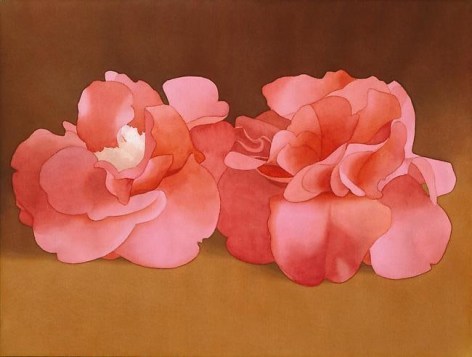




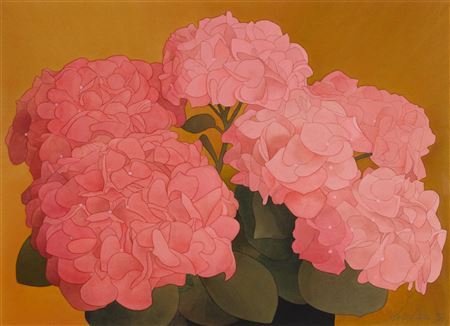
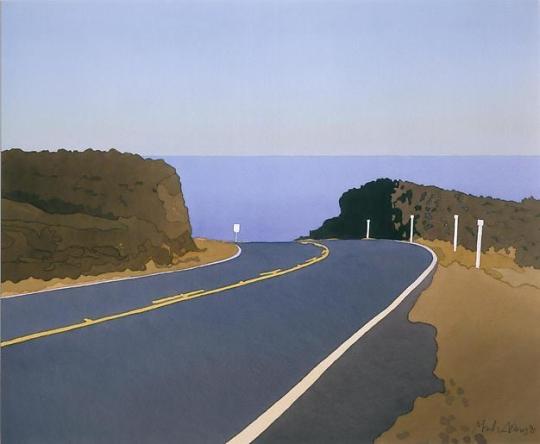
Mark Adams was born in Fort Plain, New York in 1925 and died in San Francisco in 2006. He attended the Hans Hofmann School of Fine Arts in New York City in 1945 after studying for two years at Syracuse University. He spent the next few years traveling between New York and California before he settled in the San Francisco Bay Area in 1952. Adams married fellow artist Beth Van Hoesen in 1953, and completed a four-month apprenticeship in Aubusson tapestry with the acclaimed Jean Lurcart in Saint-Cere, France in 1955.
Mark Adams is best remembered for his versatility as an artist, possessing talent in a diverse array of artistic media including tapestry, stained glass, oil painting, mosaic, drawing, watercolor, and printmaking. Early in his artistic career he focused on tapestry and stained glass. By 1962 Adams had two solo exhibitions of his tapestries at the de Young Museum and the San Francisco Museum of Modern Art. He completed tapestry commissions for various institutions, including the San Francisco International Airport. Adams also took an interest in stained glass, which he considered an extension of his work with tapestry and his enthusiasm for liturgical art.

By 1975, Adams grew frustrated with the limitations of his craft and the lack of complete control he had over the actual fabrication of his work. Drawn to the idea of small, intimate, and personal works that he could manage from beginning to end, he began a new venture in watercolour. Adams soon realized he could incorporate his techniques of flat planes of color as he had in tapestry and stained glass by using a wash to create his desired spatial effects, along with continuing his ideas of transparency and luminosity. He favored the quotidian subjects that exemplified his life, depicting them in such a way as to evoke a sense of nostalgia. Adams eventually learned to deemphasize his precise technique as a means to communicate his excitement for the subject he was portraying.
44 notes
·
View notes
Video
Maps and Masks : Non-Stellar Objects by Russell Moreton Via Flickr: Cyanotype process on paper.
#cyanotypes#modern cyanotypes#spatial transparencies#diagrams#lines#immaterial#Photography#Process.#contact prints#russell moreton#visual fine art#spatial practice#research creation#ecology of experience#useless flickr uploader#flickr
5 notes
·
View notes
Text
Mivi SuperPods Halo [Flagship Launch], True Wireless Earbuds, ANC Earbuds with 3D Soundstage, 60H Playtime, Spatial Audio, 13mm Driver, Transparency Mode Earbuds
Price: (as of – Details) From the manufacturer Adaptive Quiet ANC for proactively detecting and reducing noise before it enters the ear canal. This makes it effective against consistent, predictable noises like the bustle of a metro or the commotion of traffic while commuting on the road.Feel the new depths of 3D Soundstage taking you deeper into the sound dimension with each instrument…

View On WordPress
#13mm#60H#ANC#Audio#Driver#Earbuds#Flagship#Halo#headphones earbuds#Launch#Mivi#Mode#Playtime#Soundstage#Spatial#SuperPods#Transparency#True#Wireless
0 notes
Text
The New York State Urban Development Corporation saw in the piers a sacrificial milieu of impurity and devaluation. Rivera described the event as follows: “It’s called a sweep. Not even a fucking eviction. A sweep, like we’re trash.” [...]
The clearance operation of the piers took place under the New York Slum Clearance Commission and Law and its frothy utopian verbiage of “sanitizing” an environment [...] unsuitable for human life. [...] The demolition of the piers showed the violent clash of two confronting forms of urbanism. [...] [Manhattan’s] working class industrial base was transformed into a corporate and service-based economy and New York State Governor Nelson A. Rockefeller, together with city planners, implemented policies to frame Manhattan as a place for work, but not living. [...] The rhetoric used by public and private officials to get rid of the piers was embedded in medical metaphors, [...] "blight" [...]. At the same time, these discussions were imbricated with racial depictions and xenophobic targets: most of the constructions beleaguered in this operation were inhabited or used by black people, Latin Americans, migrants, and displaced communities. [...]
---
The piers thrived with life. [...]
The notion of the piers as insalubrious areas that needed to be wiped out gained traction in the 1980s - during the peak of the HIV/AIDS crisis [...]. This narrative concerning the piers was active in New York City until the early 2000s, until Mayor Michael Bloomberg and Governor George Pataki opened the Greenwich Village segment of Hudson River Park on May 30, 2003. The highway was finally demolished [...] and a series of gates were erected to keep Pier 45 closed after 1am [...]. The previous residents of these spaces were just routine casualties. The new proposal opted for a unitary, straightforward, apparently open but constantly surveilled set of facilities, where constant circulation (by car, skate, bike, foot) was central, and framed the conception of the piers as a passing point. This contrasted the labyrinthic and fragmented former setting, with multitudes of hidden spaces that provided a sense of privacy and safety [...].
---
The history of the piers runs parallel to the history of the LGBTQIA+ movement in New York. This is where Sylvia Rivera and Marsha P. Johnson decided to locate the first installment of [...] (STAR) in 1970 [...], a year after the Stonewall riots. [...] [D]uring the 1973 Gay Pride Rally [...], [Rivera] asked the movement to support [racialized, trans, gender non-conforming, homeless, and incarcerated people] [...] instead of just focusing on cis "men and women that belong to a white middle class club" [...] [which entailed] the negation of alternative forms of living [...].
Members of these groups were ostracized and deprived of typical considerations during the outbreak of an epidemic: protocols of announcement, transparency in information, research, and measure-taking. Meanwhile, the communities that congregated around the piers, and the piers themselves, helped spread information about AIDS, made transparent the available data, and offered care among affected communities. Groups and associations like STAR, Gay Men's Health Crisis, and Gran Fury were essential in this effort. [...] This environmental activism, where kin was formed [...], happened in places like the piers. [...] They were an escape from the constant scrutiny of authorities and from homophobic attacks [...].
---
AIDS' first name, GRID (Gay Related Immune Deficiency), as well as the common “gay plague” and “gay cancer” epithets, strengthened the idea of a specifically gay disease related to a certain environment-specific villain. Journalists, following the views of public health authorities, blamed the epidemic on [...] the places gay people frequented. [...] Physicians thus described a spatial configuration located in downtown Manhattan [...] which [...] posed a threat [...]. This claim had terrible consequences for the activist spaces and urban fabrics that confronted the epidemic [...]. The remnants of Pier 45 were demolished. The activist history of these places was “cleared.” [...]
---
When Sylvia Rivera shouted to the authorities “stay away from my house!” while being evicted, “house” not only referred to the physical construction of her home. She was confronting teleological progress with the project of a[n] [...] assemblage based on [...] mutual caring [...] and defying colonial narratives of race, sex, gender, and nature. The territorialization of epidemics, identities, and citizenship not only shape the built environment, but the built environment shapes them in return. Architecture thereby assumed the form of an expanded spatial practice [...].
When Rivera was trying to save her home from demolition, she said, “there’s so many fucking buildings in this fucking Manhattan.” What New York City was losing with the demolition of Pier 45 was not just a series of dwellings. It was losing a complex ecosystem of coexistence.
---
All text above by: Iván López Munuera. “Lands of Contagion”. e-flux Architecture (Sick Architecture series). November 2020. [Bold emphasis and some paragraph breaks/contractions added by me.]
#abolition#colonial#imperial#ecology#landscape#pathologization#carceral geography#tidalectics#health and sickness
124 notes
·
View notes
Text
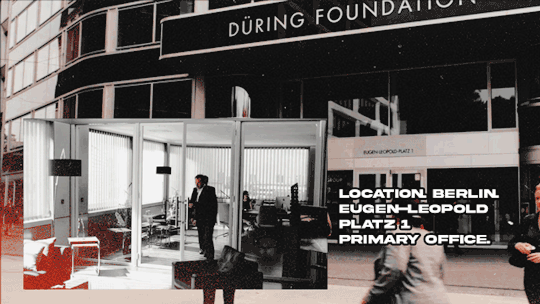
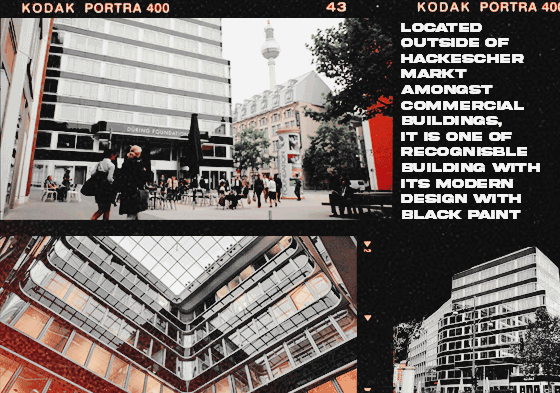
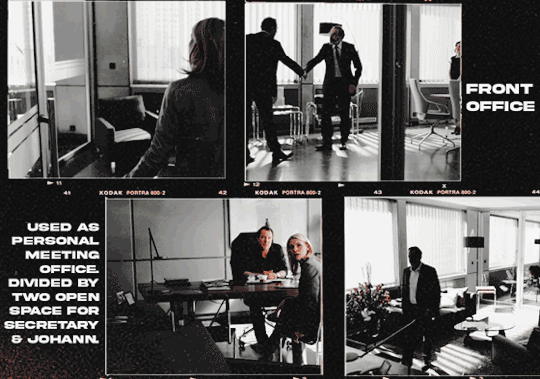
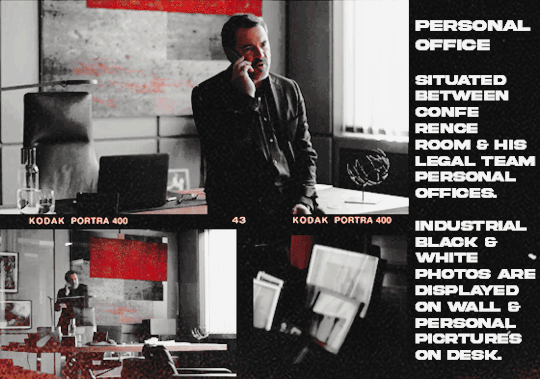
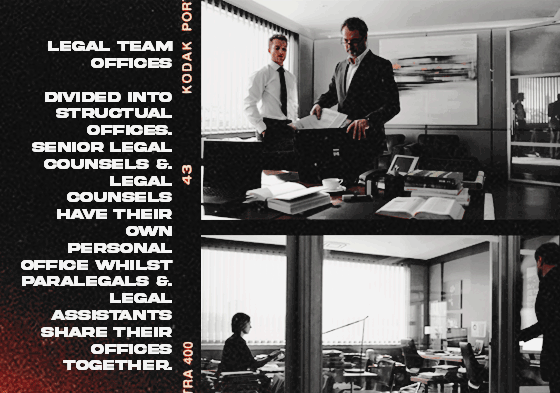

LOCATION. JOHANN'S PRIMARY OFFICE. Eugen-Leopold Platz 1, berlin.
Johann works in undisclosed subsidiary security company from Switzerland &. the company's headquarter is located in Eugen-Leopold Platz 1, outside of hackescher markt, berlin. it is one of most recognizable buildings amongst of commercials buildings on the corner of the market as it was meant to be built for an advertisement company by its completion in 2011, however after four years of operation, the advertisement company had gone bankrupt &. the security company chose its new headquarter place in berlin.
Designed by Hermann Schultz, this 8,800 m² building was an actualization of the previous company's vision: Orchestra of Ideas. The building was designed to mimic a modern orchestra house &. its interwoven instrumental imagery. The work surfaces are arranged around the central stage, with an atrium connecting all of the floors &. work spaces. the ground floor has reception, lobby, restaurant &. urban space. the company chose this building as a perfect cover-up of security services dealings that go through the company; an orchestra of safety.
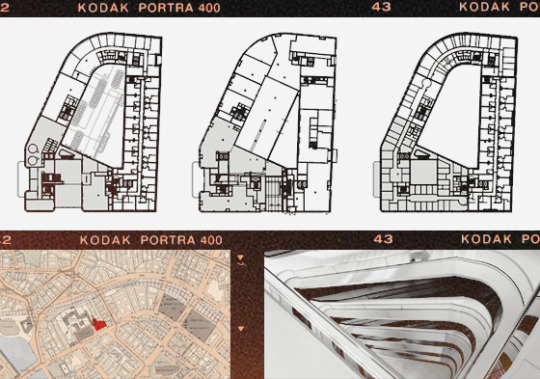
As general counsel of the company, Johann's office is located on the sixth floor of this eight stories building. The whole floor is floor is for the legal department. the office is a combination of closed but transparent office cells with open areas that create a spatial continuum that enables informal encounters &. concentrated work at the same time.
Upon walking from the escalator / lift, the visitor will be welcomed by the front office where johann's secretary resides &. a guest meeting room as an extension of the front office. within the front office, there's a modern designed sofa for the visitor to sit whilst waiting for the meeting. because of the transparent window/door that divide the front room &. the meeting room, a person can see the meeting takes place.
furthermore, when a person walks through the lobby on the left side of the front office, soon they will be welcomed by a bigger meeting room, of which people call it as a conference room. within this place, it can hold about twenty to twenty five people thus accommodating larger discussions / meetings than the front office. on the right side of the conference room, there's a couple of paralegals &. legal assistants offices. the senior legal counsels &. legal counsels offices are the left side as an extension from the press conference room which eventually make a box shaped floor.
johann's office is situated between the conference room &. legal counsels' offices. upon walking to his office, a person will be welcomed by modern abstract painting that matches the modern facade of the building alongside of several black &. white industrial photographs captured by johann's friends. there's also modern black sofa in between before johann's personal desk. johann's personal desk is a modern oak table with dark green deskmat &. trinkets such as steel globe, industrial desk lamp, personal photos on the corner of the desk &. a laptop that he carries than using computer. behind the desk, there's a small storage that keeps documents &. books he reads &. a safe box beside of it. there's not much that can describe his personality, however he keeps personal photos such as a picture of him &. his mother on his first day as a law student, a picture of him &. his cousin, nina, &. pictures of nina's triplets as well as one of triplets' drawing he keeps as a reminder of the family he barely connects despite being in germany.
johann continuously goes back & forth between his office in bern, new york, london, &. others however he sees the berlin office as his primary office.

10 notes
·
View notes
Text

Throughout the Assemble project, I worked with wire about four or five times, and I realized it’s not a medium I enjoy. The tactile experience of bending, twisting, and shaping wire was unpleasant for me. Using pliers, cutters, and other tools required too much effort and felt uncomfortable. Even the final outcome didn’t feel satisfying, it looked incomplete, more like a prototype or a framework (a mesh) rather than a finished piece. The transparency and gaps in the structure didn’t align with the type of work I enjoy creating.


However, I do see the value of wirework in developing spatial thinking and engineering skills. It’s a great tool for visualizing and planning 3D concepts, which can be helpful for complex projects. For my Transmission Tower sculpture, I used wire to represent order and artificiality. While the concept itself appealed to me, the finished piece felt too bare and uninspiring. I decided to deconstruct the sculpture and reimagine the ceramic insulator elements I had made earlier. These pieces were chaotic and experimental, glazed in various ways, and I ended up connecting them into a new sculpture using wire.

This final piece turned into something I loved. It resembled an abstract object and embodied both chaos and connection, aligning perfectly with my project’s concept. Although wirework isn’t my favorite medium, this process taught me how to rework and rethink ideas to create something meaningful.

#assemble#fusion#chaos and order#wire and light#wire#transmission tower#clay#sculpture#construction#natural and artificial
3 notes
·
View notes
